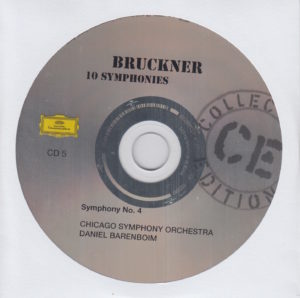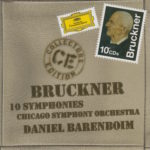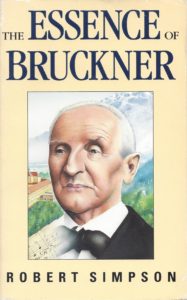 This morning begins a new symphony, a return to the first conductor in my 16-day cycle, and a whole bunch of new stuff to learn and hear.
This morning begins a new symphony, a return to the first conductor in my 16-day cycle, and a whole bunch of new stuff to learn and hear.
So, with a cup of Eight O’clock Coffee by my side, and sleep crusties still in my eyes (it’s 6am, y’all), I begin listening to…
Symphony No. 4 in E Flat Major (WAB 104), titled “Romantic” by Bruckner himself, as interpreted by Argentine-born pianist and conductor Daniel Barenboim (1942-). Barenboim leads the Chicago Symphony Orchestra.
 If you’re just joining me, the whole story of what I’m doing can be found here. But I’ll give you the nickel tour of my psyche here and now…
If you’re just joining me, the whole story of what I’m doing can be found here. But I’ll give you the nickel tour of my psyche here and now…
I am a Marketing and Public Relations guy by profession, and have been for over 25 years. Lately, I’ve been doing more life-coach consulting and writing. But, I am a marketing strategist and copywriter at heart. (I’ve been told I have a “radio voice.” And I did do a segment on a local radio station once in my stint as Marketing and PR Director for a community theatre group.) But I’m mostly a behind-the-scenes guy.
Also, I listen to a lot of Classical music, often on the radio as I drive.
Our local Classical station (WBLV, Clear Lake Public Radio, 90.3/88.9 FM) is delightful, playing a depth and breadth of music unlike any station on the dial. Not just Classical, either. Terrific Jazz as well. Plus, A Prairie Home Companion. WBLV 90.3 FM has something for everyone with good taste.
Anyway, one day as I was behind the wheel of my car (good thing, too, because I could have gotten arrested if I was behind the wheel of someone else’s car), I heard WBLV play what I later learned was Bruckner’s Eighth Symphony…and fell in love with it.
As is my wont, I wrote down the name of the composer, the name of the symphony, and its conductor (likely Herbert Von Karajan) and ordered the CD from Amazon as soon as I got somewhere with WiFi. A week or so later, according to my order history on Amazon, I ordered a CD of two Klaus Tennstedt-conducted Bruckner symphonies, the Fourth and the Eighth.
I’ve been a Brucknerian ever since.
I first encountered Maestro Barenboim in my 144-day project on Day 1, Day 17, and on Day 33. If you’re interested to know what I wrote about those encounters, let your mouse do the walking (do people these days still use a mouse?) over to those pages.
Before I dive into the subjective aspects of what I’m hearing, I like to post the nuts and bolts, the objective elements. Just the facts, Ma’am, and all that.
My day usually begins at 5:01am. (I like setting my alarm for time that ends in “1” – 5:01, 5:31, etc. Anybody can get up at 5:00. But I like to be able to say I get up at 5:01. It’s precise. And a little odd.)
By 6am, I’m usually sitting in a restaurant listening to Bruckner and blogging. Or I’m sitting in a restaurant with my wife having breakfast, my favorite meal of the day.
If I’m at a restaurant blogging at 6am, I’ll be there for, roughly, three hours – 6 to 9. Then I go to the office to work on other writing projects (screenplays, books, blogs). If I’m at a restaurant with my wife at 6am, I’ll get somewhere to start listening and blogging by 7am, wrapping up around 11am.
That’s my schedule seven days a week, with the only variation being what happens on the weekends. I still arise between 5:01 and 5:31. I still go somewhere to listen to Bruckner and write about it. But, on weekends when I’m done I’ll go back home to hang out with my wife. No real work on the weekends.
But Bruckner continues without interruptions. Seven days a week. And will for the next nearly 100 days.
More facts this morning: People from 15 different countries are now visiting my web site. Those countries are:
United States
Russia
Germany
United Kingdom
Austria
Italy
Switzerland
Andorra
Argentina
Belgium
Canada
Iran
Netherlands
New Zealand
Spain
(I listed the countries in order of the number of visits.)
To all of you, Thank You.
I realize and freely admit I am not a musicologist. I’m barely even a musician. (I play guitar now and then.) All I really am is a guy who likes to write and loves music. If anything on this site inspires you to explore Bruckner or one of these conductors or their orchestras or even the record labels on which these symphonies appear – or even WBLV Blue Lake Public Radio – my work here will be a success.
I mean, I’m doing this first and foremost for myself. If no one visited this site, I’d still be pleased that I challenged myself, learned a great deal, and then moved on to my next creative project.
But having people visit my site sweetens the deal.
So I do thank you most sincerely.
 From pages 112-113 in book The Essence of Bruckner by Robert Simpson,
From pages 112-113 in book The Essence of Bruckner by Robert Simpson,
Soon after finishing the first version of No. 4, Bruckner began work on the Fifth, starting with the Adagio in February, 1875. His circumstances were difficult; he had very little money – only the fees from his ill-paid teaching at the Konservatorium in Vienna – and his work was not arousing much interest. He was not at home in the sophisticated capital and was regretting having moved from Linz, where he had been happy in a sympathetic atmosphere.
The whole symphony was done by May 1876. He retouched it in 1878, but not again after that, and its first publication was supervised by Franz Schalk during the composer’s last illness in 1896. Schalk’s wholesale re-orchestration of the work, his ruinous truncation of the Finale, and his introduction of an extra brass band at the end are now history and need not be detailed here…
It has often been noted that this is the only Bruckner symphony to begin with a slow introduction. The obvious reason for this is Bruckner’s slow pace. A less obvious reason is that all the other symphonies do have brief introductions…It is Bruckner’s nature to begin with an intake of breath; whatever caused his personal diffidence also brought about the magical beginnings of most of his symphonies.
From its entry on Wikipedia:
Symphony No. 4 in E-flat major (WAB 104) is one of the composer’s most popular works. It was written in 1874 and revised several times through 1888. It was dedicated to Prince Konstantin of Hohenlohe-Schillingsfürst. It was premiered in 1881 by Hans Richter in Vienna to great acclaim.
The symphony’s nickname of Romantic was used by the composer himself. This was at the height of the Romantic movement in the arts as depicted, inter alia, in the operas Lohengrin and Siegfried of Richard Wagner.
VersionsSince the 1930s Bruckner scholars have generally recognised three principal versions of the Fourth Symphony, but two of these exist in more than one form:
Version I: 1874
Version II: 1878–1886 (or, possibly, 1876–1886)
Version III: 1887–1888At least seven authentic versions and revisions of the Fourth Symphony have been identified.
Between Bruckner’s penchant for revisions, and the meddling of others around him, it’s a wonder we have anything of Bruckner’s authentic compositions to which to listen today. Indeed, this matter has been termed the “Bruckner Problem” and it has an extensive entry on Wikipedia.
Bruckner’s Symphony No. 4 in E Flat Major composed in 1874
Daniel Barenboim conducts
Barenboim used the 1880 version
Chicago Symphony Orchestra plays
The symphony clocks in at 63:42
This was recorded at the Medinah Temple in Chicago, November, 1972
Barenboim was 30 when he conducted it
Bruckner was 50 when he composed it
This recording was released on the Deutsche Grammophon record label
Bruckner wrote his symphonies in four parts. The time breakdown of this one (Symphony No. 4 in E Flat Major, 1878 version), from this particular conductor (Barenboim) and this particular orchestra (Chicago Symphony Orchestra) is as follows:
I. Bewegt, nicht zu schnell (With motion, not too fast) (E-flat major)…………..18:05
II. Andante, quasi allegretto (C minor)…………………………………………………………..15:44
III. Scherzo. Bewegt (With motion) – Trio: Nicht zu schnell (Not too fast) (B-flat major)………………………………………………………………………………………………………………..9:32
IV. Finale: Bewegt, doch nicht zu schnell (With motion, but not too fast) (E-flat major)………………………………………………………………………………………………………………20:21
Total running time: 63:42
Of the 1880 version, its entry on Wikipedia reads:
After the lapse of almost a year (during which he composed his String Quintet in F Major), Bruckner took up his Fourth Symphony once again. Between 19 November 1879 and 5 June 1880 he composed a new finale – the third, though it shares much of its thematic material with the first version – and discarded the Volksfest finale. Thus the 1880 version is the same as the 1878 version but with a new finale. This was the version performed at the work’s premiere on 20 February 1881, which was the first premiere of a Bruckner symphony not to be conducted by Bruckner himself. This version is sometimes referred to as the 1878/80 version.
Okay. Now for the subjective stuff…
My Rating:
Recording quality: 5
Overall musicianship: 5
CD liner notes: 4 (short essay on Bruckner titled “Nine in number, eighteen in total” translated into English, German, French)
How does this make me feel: 5
A wonderful, wonderful piece of music.
I listened to Bruckner’s Fourth Symphony some 4-5 times today. Each time, I enjoyed different passages, different passages within movements, heard different instruments.
I love Movement III (Scherzo) because of the horns and trumpets and the feeling that I’m in, according to Bruckner’s own description, a “hunt.” It sounds like the soundtrack to the classic 1936 Hollywood film The Adventures of Robin Hood starring Errol Flynn, Olivia de Havilland, and Basil Rathbone. When I hear music like this, I want to fence. Or swashbuckle. Or fence and swashbuckle. It’s really fun, stirring music.
The Finale is every bit as triumphant and emotional as I’ve come to expect from Bruckner. I felt like jumping to my feet and shouting “Huzzah!” when it was over. (And, trust me, “Huzzah!” is not something I should willy-nilly.)
Lots of French horns in this piece of music. A bit of pizzicato.
But, more than that, there’s a magic to this composition. It’s filled with magic and mystery and joy and good fun.
Highly recommended.

Re: Reader’s countries
Not entirely true.
I am from India.
Welcome, Kanishk!
When I wrote those words on November 20th, the number of countries represented by visits to my site was only 15. Today (January 25, 2017), the number is 21.
I’m glad you found my 144-Day project.
I hope you stick around and offer more comments.
– Bill